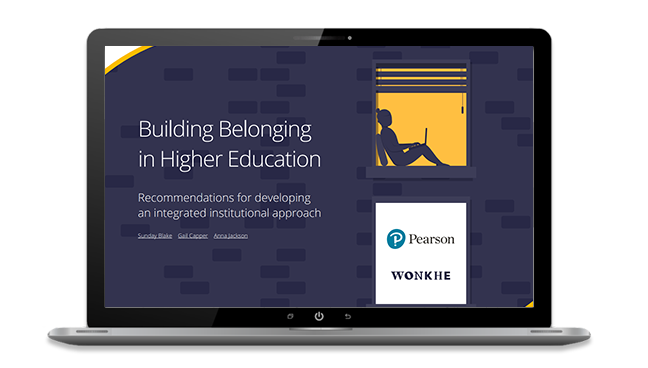Building belonging online and why it's critical to academic success
January 2023 - Helen Brown
A new report from Pearson and Wonkhe shows that building a sense of belonging in a University course is critical for students to achieve academic success. According to the report, fully online delivery performs least well in providing a sense of belonging compared to face-to-face and bi-modal provision. So, what can be done to build a sense of belonging for online distance learners?

Why is it important to build a sense of belonging for students?
As well as improving overall well-being, a sense of belonging motivates students to learn and boosts engagement in learning activities. This leads to greater academic success and commitment to the institution as a whole.
How can we create a sense of belonging in an online course?
Several models of retention demonstrate that peer and faculty interactions are one of the key factors that influence a student’s commitment to a course and ultimately whether they decide to drop out or stay.
Create connections with peers in the course
“[Belonging is] having people around me who I connect with, who I can support and who I know will support me. It is about connecting with others. When these connections are made you get a sense of security and acceptance.” Student (Pearson/Wonkhe p.12)
Connections made with other students are an essential basis for building confidence which leads to better engagement in academic content. The report findings showed the importance of peer connections within the course itself (as opposed to purely social connections) – the significance of which was often overlooked by tutors. Group work and discussions are opportunities for building these connections but these must be well planned and thought through before they are implemented. Students approach group work differently so, understanding this and designing the task accordingly, is essential. It’s recommended to keep it low stakes at first and individualise the assessment rather than mark as a group.
Create connections with course educators
“Knowing that I can reach out to lectures and year tutors and get a timely, kind and helpful response has helped any insecurities or doubts a lot this semester!” Student (Pearson/Wonkhe p.13)
Connections with tutors and module leads are important to make a student feel like they are supported, academically engaged and on the right track. The report found that ‘students appreciate it when digital communications are tailored, personal, and from a consistent or sole point of contact’ (Pearson/Wonkhe p.16). Communication for distance students is nearly always asynchronous so its critical to get it right. Candid and regular communication personalised to the course can make the individual student feel supported even when the whole cohort is being addressed. By doing simple things like filling out your full profile with a picture in Canvas allows the students to get to know you more and will encourage them to do the same.
Focus on inclusion
According to the report “57 per cent of students with a disability reported accessibility issues to teaching and learning resources due to a physical or mental health condition.”
Making an online learning environment accessible is vital so it can be accessed, understood and used by all students regardless of ability or disability. The report shows there is a direct correlation between how accessible a course is and a feeling of belonging. The Canvas templates we use in EE are fully accessible and we work with Creative Media who produce accessible video for us. Inclusive design is also about remembering people learn in varied and different ways. By providing a range of learning activities that break up teaching material into manageable chunks we can accommodate for neurodiversity and make it more interesting and engaging for everyone!
Download the full Building Belonging in Higher Education report.

Summary
Building a sense of belonging in an online course can be achieved by nurturing peer and staff connections, accessible materials and providing a variety of learning activities.